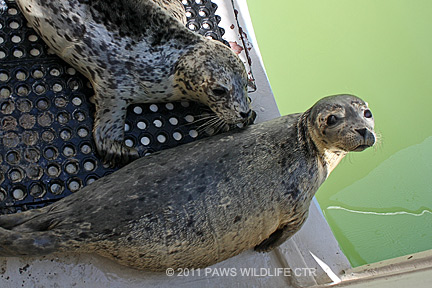Oct 2011
Off leash dog scares Abe at Lincoln Park
Oct/23/11 07:19 PM
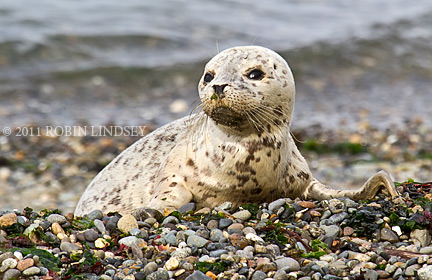
We plead with people over and over to please keep dogs leashed near the beach and to respect the city ordinance that dogs are not allowed on any public beach. A dog’s sense of smell is amazing - and one can just never predict how a dog will react when they discover a seal is on the beach. This is a good example of how a dog owner can overestimate the control they have over their pet and underestimate the pet’s reaction in these situations. The dog owner was apologetic. We were very lucky today that this seal pup was not seriously mauled or killed. Had Abe been ill or trying to heal from an injury, he would not have been able to escape. Abe did not return to shore.
Seal pup Spanky visited his favorite rock again today, but returned to Puget Sound at high tide.
Seal Sitters get a respite today after dawn to dusk days
Oct/20/11 11:01 PM
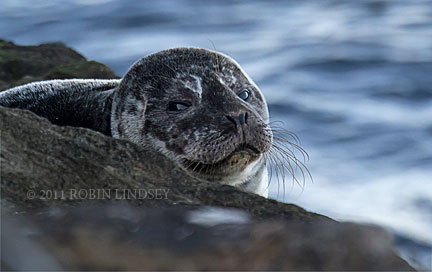
Sly, who had been looking too thin and spending more and more hours on shore, finally returned to Elliott Bay early Tuesday morning. Since that time, he has not been observed on his favorite haulout rock. We’re hoping that his many hours of rest has given him the strength to forage and pack on some desperately needed pounds. A small white pup who could be Sly has been observed along with several other pups fishing and lingering in the waters nearby. As pups are weaned and become thinner, their immune system is suppressed, making them vulnerable to parasites and viruses. Small fish seem to be plentiful now around West Seattle and Sly could use a second trip through the buffet line.
We have two additional newcomers: Noche who spent the evening on the south end of Alki Beach Sunday (our fourth pup onshore that day) and Abe who came ashore at Lincoln Park on Tuesday. This is one crazy pup season we are having this year - and the volunteers are loving it!
"A double seal pup on the rocks, please"
Oct/18/11 06:34 AM
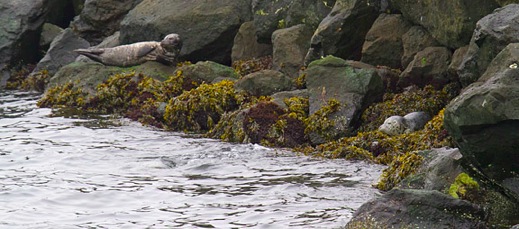
These have been very long and cold days for our volunteers. It would be nice to think that constant vigilance is not necessary, but each day we have had intentional breaches of the tape barrier. Once the tide recedes, the pups are quite high on the rocks and, if scared, face an extreme risk of falling with possible injury. Both pups have already taken such a tumble this past week.
We have also had visits on the west side by seal pups #38 and 39. Please check back for photos/video and updates about these new pups.
Stranding network on alert following West Seattle oil spill
Oct/16/11 09:09 AM
The NW Marine Mammal Stranding Network (including Seal Sitters MMSN) has members trained in oil spill response and is on alert for any animals impacted by the oil spill this week (see WS Blog’s excellent coverage). An intense 3-day workshop in oil spill response with followup hands-on training was provided by NOAA following the Gulf catastrophe. Many members of the Northwest’s network received this training. Weaned seal pups are especially vulnerable, since the smallest bit of oil can greatly impact their tenuous health this time of year. Additionally, there is a private raft located close to (and now possibly within) the spill radius which is heavily used by adult seals and pups, river otters, cormorants and herons. Should you see any affected animals (or birds), please call Seal Sitters’ hotline at 206-905-7325 and we will immediately notify the NWMMSN spill response team. Animals may be impacted for many weeks to come, so please be on the alert.
Diehard volunteers bundle up to safeguard pups
Oct/14/11 10:03 PM
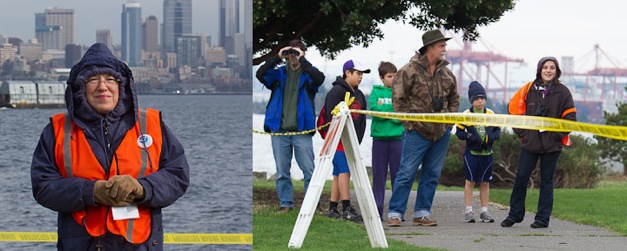
Sly spent almost 11 hours resting on the rocks, returning to the Sound at evening high tide. A kayaker came too close for a look, scared Sly and he fell onto the rocks below. This is the third incident this season (and the second in two days) where people or dogs have scared a pup high up on rocky banks and the pup has fallen. Please keep your distance whether on land or out on the water. Pups cannot maneuver well on shore (and especially on rocks) so are vulnerable to injury if they are frightened and try to escape. Umbreon did not come ashore today.
Two seal pups on shore again today
Oct/13/11 08:53 PM
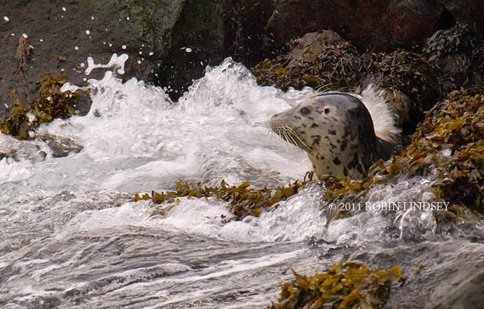
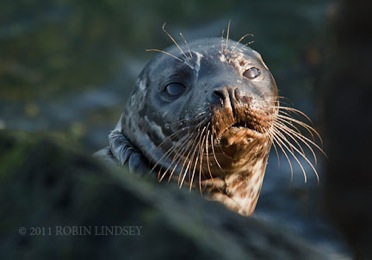
Seal pups get national media coverage
Oct/13/11 06:26 AM
Seal Sitters and our bumper crop of seal pups are receiving national attention thanks to a feature story by Associated Press. The story which was released yesterday has been picked up on websites nationwide. People in Philadelphia, Boston, Denver, Atlanta, San Francisco and in smaller communities across the US are reading about seal pup Sly and his friends. Many thanks to writer Phuong Le and photographer Elaine Thompson for such a great story! Read the article here.
Curious pup delights volunteers and public
Oct/11/11 06:13 PM

Late in the afternoon, Sly quite reluctantly returned to the water, but only when waves at high tide rushed repeatedly over him. Then, to the delight and surprise of volunteers and onlookers, Sly swam close-in along the shore towards the small group on the bank.
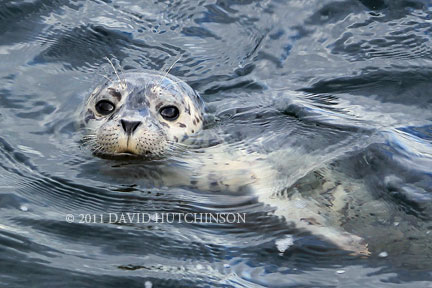
Sly little pup finds a rocky spot
Oct/09/11 09:38 PM
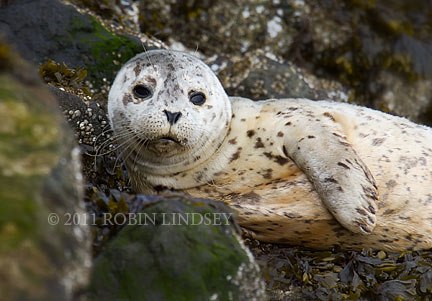
Pups keep volunteers busy on beaches north
Oct/09/11 09:33 PM
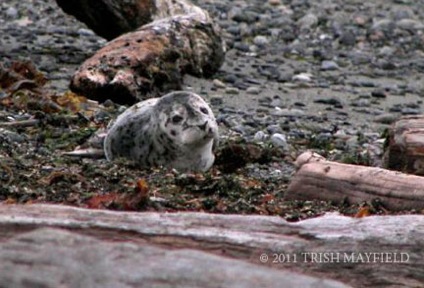
Volunteers monitored this alert and seemingly healthy pup who does have a small nick on his nose. Most seals in the wild have minor cuts or abrasions, so it’s not always a health concern. In fact, we have had several pups over the last few years with infected wounds (some pretty severe) that have healed with just rest and salt water.
We have reports that Edmonds has had a busy pup season thus far, too. If you see a pup on the beach along the Edmonds waterfront, please call Edmonds Seal Sitters @ 425-327-3336. Seal Sitters MMSN responds to all other beaches stretching from West Seattle to Marysville’s Kayak Point. Thanks to all the Sno-King and Edmonds SS volunteers who are doing such a great job protecting the pups and educating the public, including the concerned young woman who was way too close to Teaser with her leashed dog.
Stranding Networks play important role in Northwest
Oct/07/11 07:59 PM
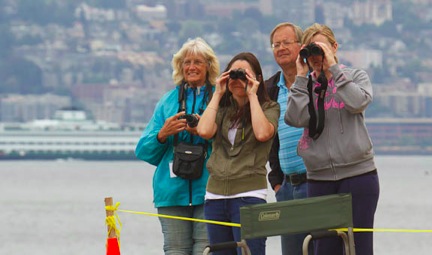
“Seal Sitters MMSN, part of NOAA's Northwest Marine Mammal Stranding Network, responds to reports of live and dead marine mammals from West Seattle to Marysville. The NWMMSN consists of a number of organizations, including WA Dept of Fish and Wildlife and Cascadia Research, and many volunteers who cover the entire inner and outer coast of Washington and Oregon. Seal Sitters has a signed agreement with NOAA and therefore has the authority to establish any necessary perimeter around a marine mammal to prevent disturbance or harassment, as per federal law passed in 1972 - the Marine Mammal Protection Act. While NOAA recommends that people stay a minimum of 100 yards away, we realize that is not always possible in an urban environment. We make every attempt to enable a marine mammal to rest onshore without greatly inconveniencing the public. That said, our primary goal is protection and safety for both the animal and the public. Sometimes, there may be a slight inconvenience in order to do so.
Seal Sitters is an all-volunteer organization and does this service and educational outreach with no monetary compensation from the City, State or NOAA.”
Please, respect both the barriers and the volunteers who donate many selfless hours, sometimes under trying circumstances. Already this season, we have had many days with pups in multiple locations. Volunteers Eilene and David (photo above) are among those who tirelessly educate the public about lovable seal pups, such as Henry along Alki Avenue. Seal Sitters greatly appreciates the support and cooperation of our community! We do have many operational expenses throughout the year, including maintaining our dedicated phone hotline and websites, as well as printed outreach and training materials. If you’d like to make a tax deductible donation to help us continue this valuable work, please click here.
Pup-ulation explosion on shores of West Seattle
Oct/06/11 08:17 PM
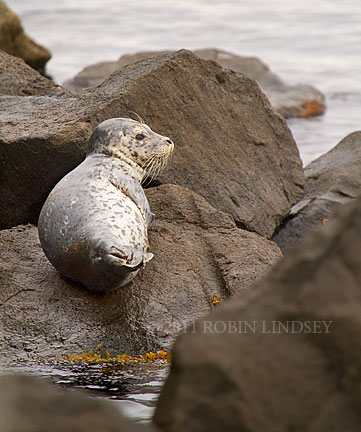
This year, from August - October 5th (yesterday), we have already surpassed last year’s five-month total: 35 different pups have now been observed and protected by our West Seattle volunteers! And October is typically one of our busiest months, so we can only guess how many pups we’ll have by the end of the year.
Our 35th pup is shown in the photo here. Nicknamed Spanky, this very robust and alert pup found a nice rock to rest upon before the incoming tide’s waves sent him swimming off into the Sound. This is just the kind of round pup with a thick blubber layer that we want to see this time of year, when too many are becoming thinner and trying to survive. Blacky, who has been using Lincoln Park for several weeks now, has become noticeably thinner the past two sightings. Seal pup Aquarius, who hauled out at Constellation Park for two days in a row, was rescued from that beach Friday, but died at PAWS. We cannot stress enough that seal pups need to rest and warm up undisturbed in order to maintain their strength and keep their immune system resilient.
Seal pup Sandy thriving in rehab at PAWS
Oct/02/11 07:56 AM
